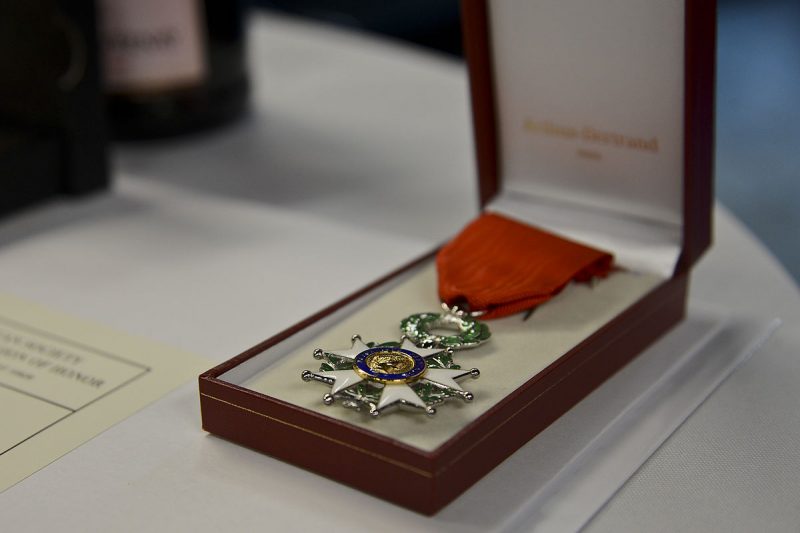George Lawson, 97, was one of ten American veterans recognized on Thursday for their contributions to France during World War II. He received the French Legion of Honor award in a ceremony at the Tampa Bay Automobile Museum in Pinellas Park.
Lawson remained seated in his wheelchair for most of the ceremony, but rose with assistance from his sons to accept France’s highest military honor. The medal is the 17th he has received for his illustrious military career that lasted nearly 30 years.
His life began humbly as the oldest of six children in rural Tennessee. His grandparents raised him and sent him to school in a one-room schoolhouse. “His grandmother told him education was the key, and he took that to heart,” said Lawson’s daughter, Lori Rutland.
He was the first of his family to graduate from high school. He wanted to go to college, but his family couldn’t afford it. “So he walked up and down the street and went into every business asking if anybody would hire him,” according to Rutland. “And they hired him at a hotel to work as the night clerk.”
He worked at the hotel during the night and took classes at Tennessee Technological University in the day, graduating in 1941 with an accounting degree.
In the summer of 1939, while still in college, he hitchhiked across the country. He traveled over 10,000 miles in 30 days with only $100 on him. During the trip, he worked as a rickshaw driver at the New York World’s Fair.
Also during the trip, he watched a group of barnstormers perform at a county fair. His interest in airplanes stoked, he learned to fly and received his pilot’s license. When the U.S. entered World War II, he enlisted in the military. He quickly moved up the ranks. By the end of the war, the skinny kid nicknamed “Tennessee Slim” became a lieutenant colonel.
He worked as a photo reconnaissance pilot for the 17th Reconnaissance Group of the 8th Air Force based in Mount Farm, England. The “Photo Joes” flew unarmed airplanes over enemy territory to scout potential bombing targets like railways and munitions factories.
“Unlike the bombers that had maybe six or seven guys on the crew, [photo reconnaissance pilots] flew by themselves,” Rutland said. “So he was the pilot, he was the navigator, he was the radioman, he was the camera operator — the whole thing.”
Recon pilots didn’t receive as much recognition as fighter pilots and bombers, but their work was vital and full of danger. To get good pictures, the planes had to fly low, which made them vulnerable to attack. The reconnaissance pilot also had to confirm that bombers hit their targets, and the enemy often was prepared for them to come back.
While in Europe, Lawson met his wife, Phyllis. She was an Army nurse. They met at a military dance in 1943. They married in 1946, just before Lawson was sent to Korea. For fourteen months, he served as the military governor of Seoul.
In 1967, he was assigned to MacDill Air Force Base and moved his family to St. Petersburg. He retired in 1970 and took a job as vice president for Bayfront Medical Center where he worked for 13 years.
Always interested in furthering his education, Lawson received his MBA from the University of Pittsburgh in 1951. All four of his children graduated from college. Two sons, George Jr. and Mark, graduated from the Citadel and served in the Air Force and Navy, respectively.
In 1997, his wife was diagnosed with Alzheimer’s and Lawson took on possibly his hardest role in life as he became her primary caregiver. She died in 2008 and was interred at Arlington National Cemetery.
Lawson, who will be 98 in August, treats his life of travel, accomplishment, and adventure with humility. He summarized his life simply, “Well, I’ve been there and done that.”
